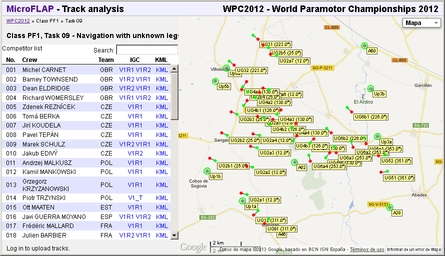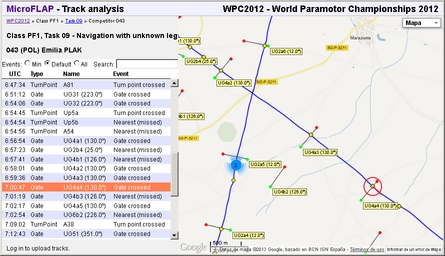Track Analysis¶
- Table of contents
- Track Analysis
This page displays the information related to a task in a class.
The task is graphically displayed on a map using the standard Google Maps interface.- Zoom in/out using the mouse wheel.
- Click and drag to move the map.
- Use the map style selector to change between map, satellite, no map... according to your preferences.
- Click on the championship name on the breadcrumbs line to return to the championship summary.
- Click on the MicroFLAP link to return to the main page (the championship list).
Competitor List mode¶

- The competitor number, crew member names and the team they belong to.
- The raw IGC track files that have been uploaded.
- The KML files (Google Earth files) including the track the task and the events resulting from the analysis.
The absence of any IGC or KML links in a competitor row indicates that no track has yet been uploaded for this competitor.
You may:- Type any text in the search box. Only the rows containing the typed text will remain in the table. Delete the text to recover all the rows.
- Click on any row to display the corresponding track and the events resulting from the analysis. This will take you to the Event List mode in this page.
- Click on any of the IGC links to download the raw IGC file.
- Click on the KML link to download the KML (or KMZ) file and view it using Google Earth.
Event List mode¶

After selecting a competitor from the competitor list, the track is displayed on the map along with the events resulting from the track analysis. The competitor list is replaced by the event list for the selected competitor.
The event table has the following columns:- UTC: the time when the event happened (universal time)
- Type: the control type
- Name: the control name
- Event: the event that took place at the specified control
Check the event types page for deeper information on events.
In addition to the map interaction described above, you can also:- Click on any of the events in the table. It will be marked as the selected event and the track cursor will be displayed on the corresponding position on the map.
- Use the mouse wheel while the mouse pointer is on the table to select the previous or next event. You can also use the up and down arrows for the same purpose.
- Hover the mouse pointer over any event mark to display its information.
- Click on any event mark to select the event. The track cursor will be displayed on the selected event and the event will be selected on the event table.
- Min: Only the most important events are displayed
- Default: Displays the events that are normally used for scoring
- All: Displays all available events
Additionally, the events can be filtered (on the table) by typing on the search box. Only the lines containing the input text will remain on the table.
To return to the competitor list you can- type the escape key
- or click on the task number link in the breadcrumbs line.
The current track won't be deleted from the map until another one is selected.
The track cursor¶


- The circumference's centre corresponds to the track point.
- A line starts from de centre and ends at some distance. This is the speed vector, representing:
- The flight direction at that point.
- The flight speed. When the line reaches the circumference, the competitor is flying at a speed of 50 Km/h. The segment's length varies proportionally to the speed.
Uploading tracks¶
If you have enough rights you can upload tracks. Click on the track upload form and select a track from your computer to upload it.
So far, you can only upload tracks in IGC format using the CIMA track file name pppTttVvRr[free text].igc, where:
| ppp | Pilot number. Valid numbers range from 001 to 999. |
| T | Letter T (stands for task) |
| tt | Task number. Valid numbers range from 01 to 99. |
| V | Letter V (stands for version) |
| v | Version number. Each time a track is downloaded from the logger it will have a new version number. It consists of a single digit. If more than nine are needed letters are used. |
| R | Letter R |
| r | Logger number: normally 1 for primary and 2 for secondary, but 3 for tertiary and so on are acceptable. |
| [free text] | Any descriptive text |
| .igc | The IGC file format extension |
This is automatically generated by all CIMA-approved loggers, allows an easy handling of files and provides information about the competitor and task to automatically process the track.
After uploading a track it is submitted for analysis. The results may be obtained immediately or not depending on the server's workload. After a track has been analysed its results will be accessible from the competitor list table in this page.
Deleting tracks¶
You also have an option that allows you to delete all the tracks uploaded to this task in this class.